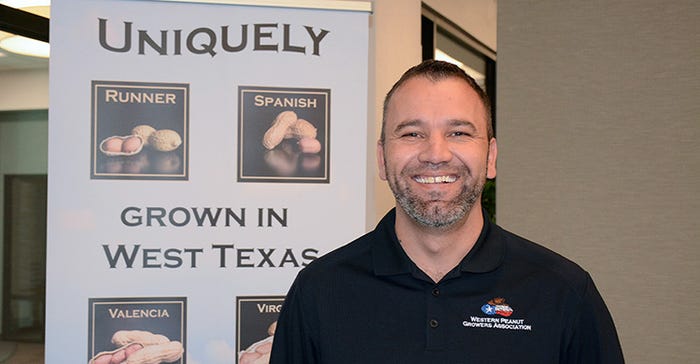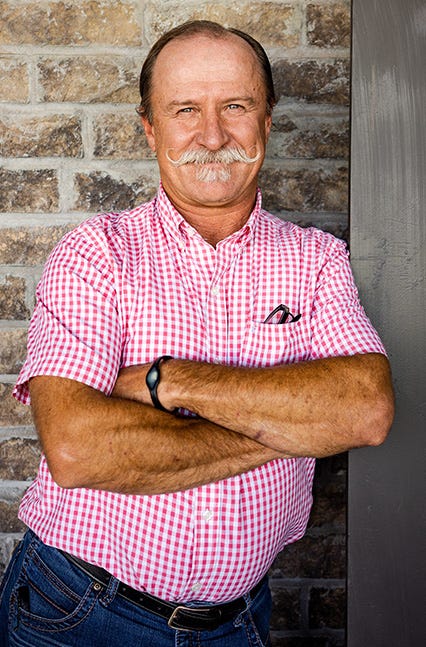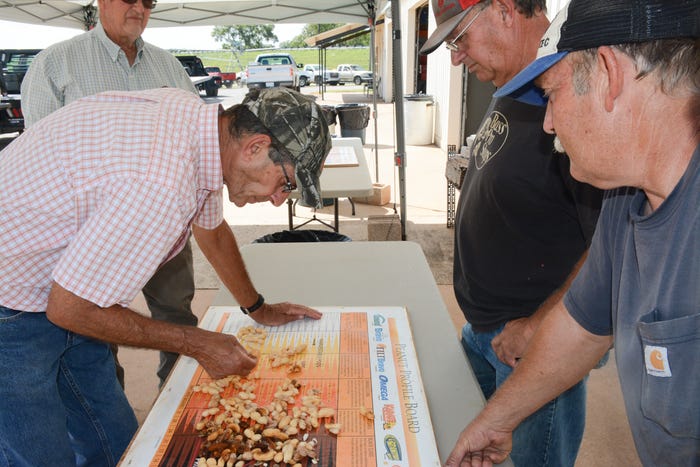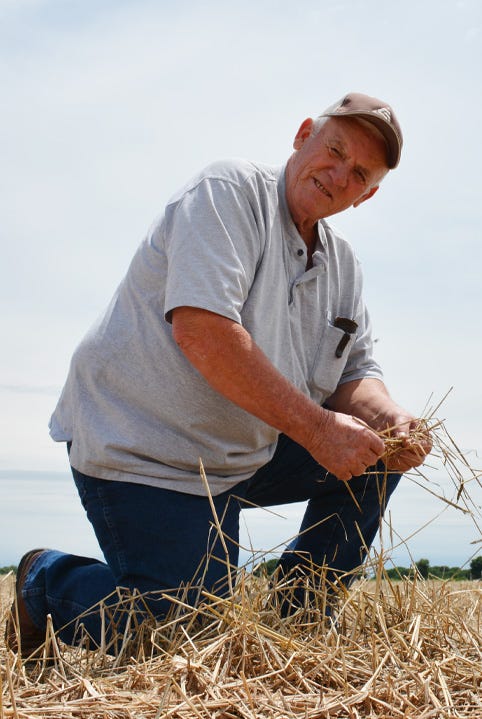
Southwest peanut farmers are taking a final look at weed and disease control options, gauging irrigation demand and availability and making sure harvest equipment will be ready to roll by early October.
It’s been a tough year. Excessive heat and persistent drought tested the limits of irrigation wells and the patience of farmers.
“We’re still irrigating as hard as we can,” says Jake Teichroeb, Seagraves, Texas.
Teichroeb says the 2020 drought is reminiscent of 2011, not as bad, but still taking a heavy toll on yield potential.
“It’s a rough situation. Drought hit hard. We lost the cotton crop and are holding on with peanuts. We will irrigate until we’re ready to dig, probably early October. The first 10 days of the month is the target.”

Jake Teichroeb, Seagraves, Texas
“I’ll try to keep the crop wet until the first of October,” says Anthony Reed, Thackerville, Okla.
He planted some dryland peanuts on contract this year. Those are gone, he says. “I’m excited about the irrigated peanuts. I’ll try to keep them wet until the first of October and might water a little longer to finish them up or keep the ground soft enough to dig.”
“If we get a rain next week (August 31) we will turn the water off,” says Clint White, Wilbarger County, Texas.
“Irrigation has been running solid for almost two months. I’m not sure if the wells will hold on; we’re pushing it.
“I might water once or twice more to finish crop; by the end of September, I’ll be looking to dig.”
No disease pressure
Had any clouds appeared during the season to offer a silver lining, the absence of disease pressure could have been it.
 (Clint White, Wilbarger County, Texas. Photo courtesy of Texas Peanut Producers)
(Clint White, Wilbarger County, Texas. Photo courtesy of Texas Peanut Producers)

“Disease issues have posed no problem,” White says. “It’s been so hot and dry water doesn’t stay on leaves long. I applied a fungicide mid- to late-July. That has held so far. Unless conditions get consistently cloudy, with cool days, we will be okay.”
Reed concurs. “With our rotation, disease is not a factor,” he says. “I put on a preventive fungicide in case we get a moist fall. Normally, after Sept. 20, we see no substantial loss if peanuts are in good shape.”
Disease is rarely an issue for Teichroeb and certainly not this year.
“I’m seeing nothing. It is so dry we have no disease pressure. We normally don’t have disease issues. Pod rot is the only concern in this dry climate. This year, we’ve had no disease pressure whatsoever.”
Digging date
As the season winds down, peanut farmers are assessing maturity and setting harvest schedules. Reed says his routine will be a bit different this year.
He and others in the Oklahoma peanut region typically take samples to the Oklahoma State University Peanut Field Day at Fort Cobb to check maturity. That field day was cancelled because of COVID-19.

“Gauging maturity will be a bit more difficult,” Reed says. “I’m going back to what dad taught me 40 years ago. I will hull scrape at home. With OSU help, I built a pressure washer to scrape them myself.”
It will be “a judgement call. I’ll use some 60’s and 70’s knowledge,” he says.
Timing will be important. “I also need to get fall crop ground ready. I don’t want to get into a situation where everyone is harvesting the last two weeks and create a bottleneck. I like to spread harvest over six weeks to two months, early October through near Thanksgiving. I don’t want to fight everyone at buying points.”
“We’re scouting fields now for diseases,” Teichroeb says. “We will start scouting for maturity in three weeks, the third week in September. We do a scratch test once a week in all fields. We check several spots across each field.”
White expects to be ready to dig by late September. “Sept. 26, is the earliest I’ve ever started. Harvest likely will begin the last week of September or the first week of October.”
Escaped weeds
Before harvest, they also check weeds that escaped in-season control measures.
“We have a few escapes,” White says, “but not enough to bother digging. We’ve had good weed control, just a few grasses up late, nothing big enough to hamper digging or harvest. We don’t need any rescue weed control applications.
“We have some pigweed; it’s a nuisance, a pain. We’ve had pretty good control with dicamba, but we’re not certain we will keep it. We need it.”
“Pigweeds are just a problem, like weather and wild hogs,” Reed says. “We’re gonna have them.”
He’s using some preventive grass sprays. “But pigweeds are hard. They escape so many chemicals.”
His says his wife, Karen, “has been pulling weeds.”
Teichroeb says losing the cotton crop freed up some employees to chop weeds in peanuts. “They are walking field with hoes and chopping weeds—mostly pigweed and some tumbleweed.”
Equipment Prep
All three say peanut harvest timing is too important to risk unnecessary downtime and delays after they get started.
“We just got started with equipment maintenance,” Teichroeb says. “We pull equipment into the barn one piece at a time. We’re just starting to replace a bunch of bearings, getting ready.”
 (Anthony Reed, Thackerville, Okla. Photo by Ron Smith)
(Anthony Reed, Thackerville, Okla. Photo by Ron Smith)

“Harvest equipment maintenance is important,” Reed says. “I wait until early September when the temperature is not so aggressive.
“I have a list in mind as I get ground ready for fall crops. I’ll check the diggers. The peanut combines were running fine last fall when we finished, but I always check the chains, sprockets and bearings and replace as needed.”
“I just left the parts house and got stuff for the digger,” White says (in late August). “It’s time to start thinking in that direction.
“I’ll check chains and perform normal maintenance. I check the normal wearing parts to get ready to go to the field and not miss out on fair weather. I want to get on the ground, dig, dry, combine and get peanuts to the buying point.”
Crop prospects
The drought, Reed, Teichroeb and White say, threatens production.
Reed expects little from the dryland. “But I am excited about the irrigated crop. We should harvest an average crop or better from irrigated fields.”
“Peanuts are fairly good,” White says. “It has been dry, but I hope we’ve seen the last 100-degree day of the summer. It’s supposed to cool off next week (Aug. 31- Sept.6).
“Cotton and peanuts look good and are on schedule. We’re just trying to get through hot weather.”
“The crop is struggling,” Teichroeb says. “We have no cotton left at all. We’re pumping all the water we have on peanuts and it’s not enough. The crop ranges between poor and fair — just not a lot of good news. It’s not quite as bad as 2011, but it’s close to it.”
Hard times
They say hard years are not unusual.
“Farming is tough as it always was and always will be,” White says. “Every year, we see something different; we just persevere and keep going.”
“We just have to man up and survive, and hope for better next year,” Teichroeb says.
About the Author(s)
You May Also Like






